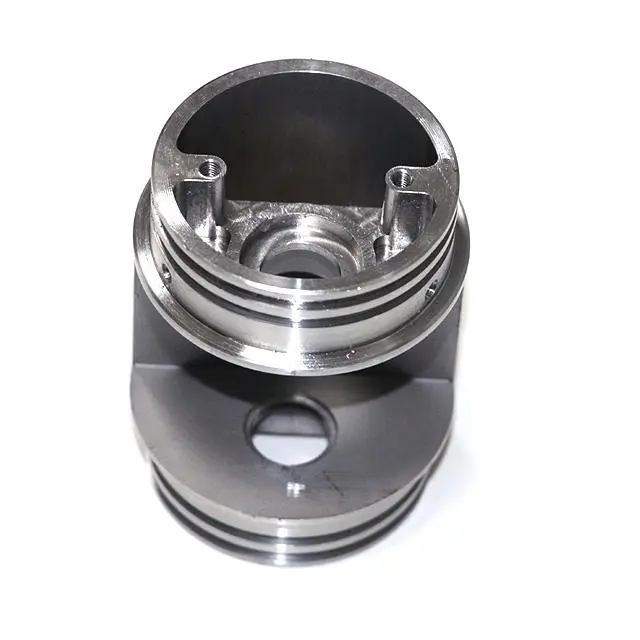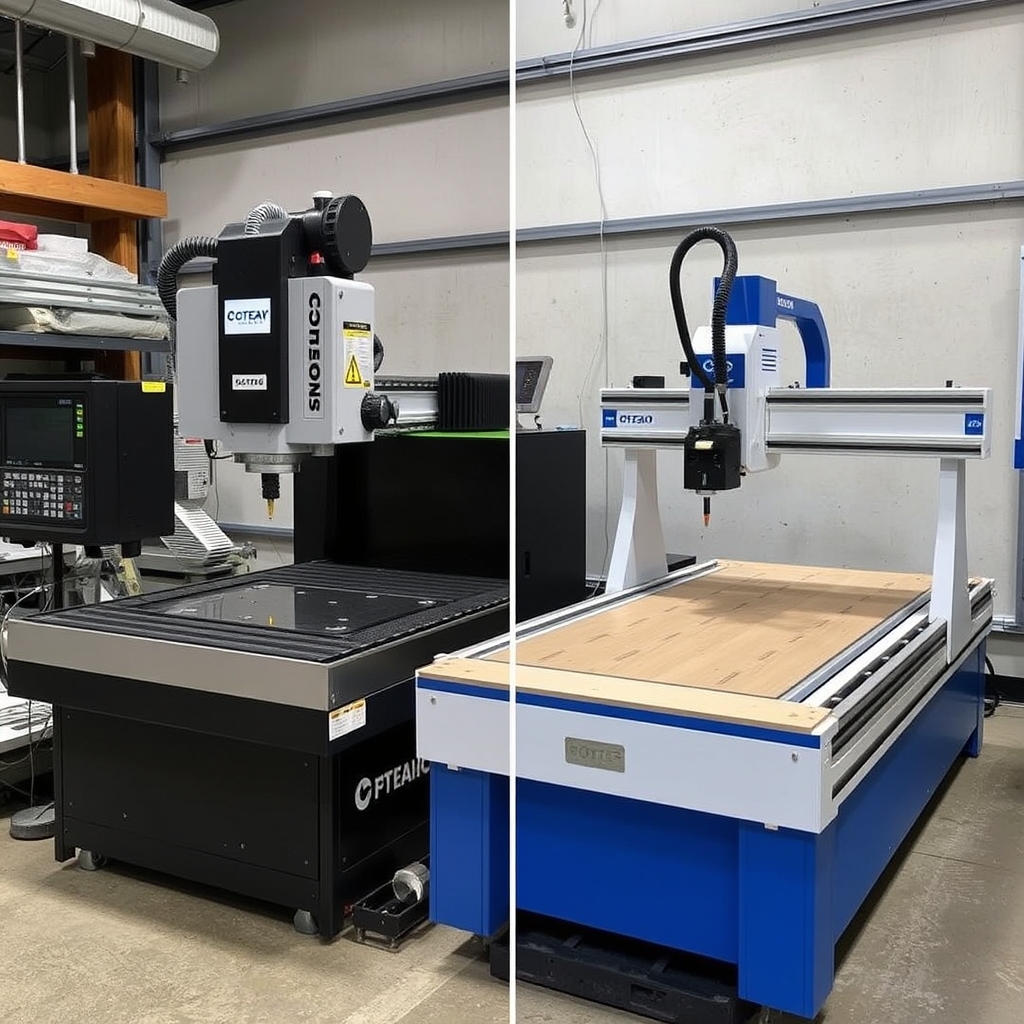
- +8615586668226
- [email protected]
- Nr. 30, Hongbang industripark, Shenzhen

A CNC-ruter er en numerisk datastyring (CNC) maskin that uses a high-speed spindel to cut, carve, and shape various materialer. CNC-styrte fresere are typically used for mykere materialer like wood, plastics, foam, and even some metaller som aluminum. They excel in creating intricate designs and patterns, making them ideal for industries like woodworking, sign making, and cabinet making.
A CNC-ruter is known for its versatility and speed. It operates on three axes (X, Y, and Z), allowing for movement in three directions. This makes it perfect for creating large, flat, and detailed parts. The spindel av en ruter rotates at a high rotational speed, and it uses specialized fresebiter to make cuts.
A CNC-fres is another type of CNC-maskin, but it’s designed to handle harder materials and more demanding tasks. CNC-freser bruk endefreser to cut a arbeidsstykke that’s usually stationary, and they are built to handle tougher materials som steel, titan, og andre metaller. They are commonly used in industries that require high precision, such as aerospace, automotive, and tool and die making.
CNC-freser are known for their precision and power. They can operate on three or more akser, allowing for complex cuts and shapes. Unlike rutere, møller have a more rigid structure, making them ideal for heavy-duty tasks. They can withstand the forces generated when cutting harder materials, ensuring accuracy and a high-quality finish. CNC mills operate with precision that rutere can’t match when dealing with tougher materials.
Den difference between a CNC router and a CNC mill lies primarily in their design, purpose, and the materialer they are designed to handle. CNC-styrte fresere are usually lighter and faster, ideal for mykere materialer and detailed work over a large work area. CNC-freser, on the other hand, are built for precision and power, capable of handling harder materials and performing more demanding freseoperasjoner.
Begge maskiner er subtraktiv produksjon tools, meaning they remove material to create the desired shape. However, the way they do it and the skjæreverktøy they use are different. CNC-styrte fresere bruk fresebiter for quick cutting on materials like wood and plastics, while CNC-freser utilize endefreser for precision work on metaller som steel and aluminum.
| Funksjon | CNC-ruter | CNC-fres |
|---|---|---|
| Materiale | Softer materials (wood, plastic, foam) | Harder materials (steel, titanium, aluminum) |
| Spindelhastighet | Høy | Lower, but higher torque |
| Presisjon | Good for detailed work but less than a mill | High precision, ideal for tight tolerances |
| Stivhet | Less rigid | More rigid |
| Kostnader | Generelt billigere | Generelt dyrere |
| Axes | Typically 3 axes | 3 or more axes |
| Bruksområder | Woodworking, sign making, cabinetry | Aerospace, automotive, tool and die making |
| Work Area | Larger work area | Smaller work area |
| Skjæreverktøy | Fresebiter | Endefreser |
Den spindelhastighet and power are crucial factors when choosing between a CNC-ruter og en CNC-fres. CNC-styrte fresere typically have high-speed spindler that rotate at speeds of 18,000 to 24,000 RPM, allowing them to cut mykere materialer quickly and efficiently. However, they have lower torque compared to a mill, making them less suitable for cutting harder materials.
CNC-freser, while having lower spindelhastigheter (usually under 10,000 RPM), offer much higher torque. This makes them capable of cutting through tougher materials without stalling or losing precision. If your work primarily involves metaller som steel or titan, a CNC-fres is the better choice. For materials like wood and plastics, a CNC-ruter will provide the speed and efficiency you need.
CNC-styrte fresere are designed to cut softer materials like wood, plastics, foam, and some light metaller such as aluminum. They are perfect for creating intricate designs in sheet material and are widely used in industries like furniture manufacturing and sign making. Routers are designed to cut with speed and precision on these materialer.
CNC mills can cut et bredt spekter av materialer, inkludert harder ones like steel, titan, og andre metaller. They are ideal for applications requiring high precision and strength. Industries like aerospace, automotive, and medisinsk utstyr basere seg på CNC-freser for their ability to handle tougher materials and deliver precise results. CNC mills are built to handle these materials, ensuring durability and accuracy.
CNC-styrte fresere typically operate on three axes: X, Y, and Z. This allows movement in three directions, making them suitable for 2D and simple 3D projects. The Z axes movement allows the ruter to move up and down, while the X and Y akser control the horizontal movement. CNC routers work best for projects that require a large, flat work area.
CNC-freser can operate on three or more akser, including rotational akser. This additional movement capability allows for more complex cuts and shapes. 5-akset CNC-maskinering are commonly used in industries that require intricate parts with tight tolerances. The ability to move and rotate the arbeidsstykke eller skjæreverktøy in multiple directions makes CNC-freser extremely versatile.
CNC-freser are known for their rigid structure. They are built to withstand the forces generated when cutting harder materials. This rigidity ensures that the maskin remains stable during operation, resulting in precise cuts and a high-quality finish. Fresemaskiner are designed to minimize vibration and deflection, which is crucial for maintaining accuracy.
CNC-styrte fresere are less rigid compared to a mill. They are designed for speed and efficiency when cutting mykere materialer. While they offer good precision, they may not be suitable for tasks that require the highest level of accuracy, especially when working with harder materials. Routers are usually faster than møller but may lack the stability needed for heavy-duty cutting.
Generelt sett, CNC-styrte fresere are less expensive than CNC-freser. You can find a decent router for a few hundred to a few thousand dollars, making them accessible to hobbyists and small businesses. They are a cost-effective solution for those who primarily work with mykere materialer.
CNC-freser are typically more expensive due to their rigid construction, advanced features, and ability to handle harder materials. The cost of a CNC-fres can range from tens of thousands to hundreds of thousands of dollars, depending on the size, capabilities, and brand. Investing in a CNC-fres is a significant decision but can be justified by the maskinens versatility and precision.
Å velge den riktig maskin depends on your specific needs and the materialer you’ll be working with. If you’re in the woodworking, sign making, or cabinetry industry, a CNC-ruter is likely the best choice. Its ability to quickly and accurately cut mykere materialer makes it ideal for these applications. CNC-maskinering can help you with projects of any complexity.
For industries like aerospace, automotive, medisinsk utstyr, and tooling and dies, a CNC-fres is the better option. Its ability to handle harder materials and deliver high precision is essential for these demanding applications. CNC-freser can perform complex cuts and create parts with tight tolerances, meeting the stringent requirements of these industries.
Som en ledende CNC-fabrikasjonstjenester provider, we have extensive experience working with various industries, including aerospace, automotive, medisinsk utstyr, electronics, and more. We offer a wide range of services, including CNC-fresing, CNC-dreining, produksjon av metallplater, og rask prototyping. Vår toppmoderne maskineri and experienced team ensure that we deliver high-quality parts that meet your exact specifications.
We understand the differences between CNC routers vs CNC mills and can help you choose the riktig maskin for your project. Our expertise in CNC-maskinering og fabrikasjon allows us to provide tailored solutions that optimize your production process. Whether you need presisjonsbearbeiding or custom fabrikasjon, we have the capabilities and knowledge to deliver outstanding results. We also offer montering tjenester.
What is the primary difference between a CNC router and a CNC mill?
Den primære forskjell ligger i materialer they are designed to handle and their construction. CNC-styrte fresere are ideal for mykere materialer like wood and plastics, while CNC-freser are built for harder materials like steel and titan. Mills are more rigid and precise, while rutere are faster and more suited for larger, flat workpieces.
Kan en CNC-fres skjære metall?
Ja, en CNC-ruter can cut some metaller, particularly softer ones like aluminum. However, it is not as effective or efficient as a CNC-fres when cutting harder metals. Routers er bedre egnet for materials like wood and plastics.
What are end mills used for in CNC machining?
Endefreser er skjæreverktøy brukt i CNC-freser for å fjerne materiale fra en arbeidsstykke. They come in various shapes and sizes and are designed for precision cutting on harder materials. Endefreser are essential for creating complex shapes and achieving tight tolerances in freseoperasjoner.
How do I choose between a CNC router and a CNC mill?
Å velge mellom en CNC-ruter og en CNC-fres depends on your specific needs, the materialer you’ll be working with, and the level of precision required. If you primarily work with mykere materialer and need a large work area, choose a CNC router. If you need to cut harder materials and require high precision, a CNC-fres is the better choice.
What industries commonly use CNC routers and mills?
CNC-styrte fresere are commonly used in woodworking, sign making, cabinetry, and other industries that work with mykere materialer. CNC-freser are widely used in aerospace, automotive, medisinsk utstyr, tooling and dies, and other industries that require precision machining of harder materials.
What software is used for CNC routers and mills?
CNC routers and mills typically use CAD- og CAM-programvare. CAD (Computer-Aided Design) software is used to create the design, while CAM (Computer-Aided Manufacturing) software translates the design into instructions for the CNC-maskin. Popular CAM software includes Mastercam, Fusion 360, and SolidCAM.
Få de nyeste trendene og fakta om CNC-fabrikasjon fra bloggen vår.
Shenzhen Runkey Precision Technology Co. Ltd, et datterselskap av Tensun Group, er din pålitelige one-stop-løsning for tilpasset produksjon fra prototyping til produksjon. Forvandle ideen din til virkelighet med digitale produksjonsressurser, strømlinjeformede prosesser, ekspertveiledning, akselererte tidslinjer og kompromissløs kvalitet.
©2024. CNC Fabrication Alle rettigheter forbeholdt.